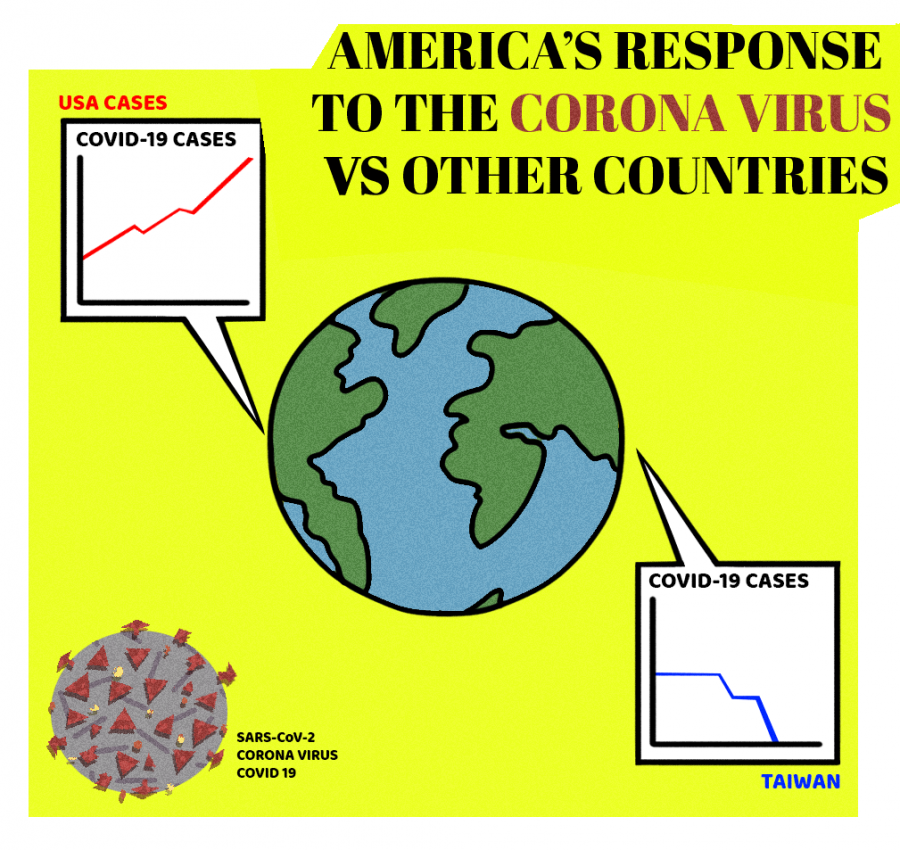America’s vs. Other Countries’ Responses to the COVID-19 Pandemic
August 25, 2020
As the coronavirus continues to spread across the globe, many leaders and their countries have been put to the test, some managing to keep the virus under control and others letting it slip out of hand. Half a year after the first case of coronavirus was reported in China, it’s become clear that the U.S. falls into the latter category, with over 145,000 deaths. Despite the U.S. having adhered to many of the same strategies that other countries have used to counter the pandemic, it hasn’t seen nearly the same results, which begs the question: What sets the U.S. apart from countries that have succeeded with their response?
It comes as no surprise that one of the most effective measures many countries have used to combat the virus is to take quick and decisive action. Taiwan, one of the first countries to respond to the threat, managed to contain the virus by imposing safety measures even before it reported its first case. Days after the World Health Organization (WHO) reported China’s first case of COVID-19, the country began screening travelers coming from Wuhan, the epicenter of the virus, for coronavirus symptoms, and imposed a travel ban on the city soon after. Taiwan’s president, Tsai Ing-Wen, continued to take additional action to prevent the spread of the virus, including implementing widespread testing and a system to track the virus. With only seven deaths despite its close proximity to China, Taiwan has undoubtedly been one of the most successful countries in dealing with the pandemic. New Zealand, another country that contained the virus, suffering only 90 deaths, as of Aug. 18, also steered clear of a crisis by taking early action, enforcing self-isolation on people entering New Zealand at a time when only six cases had been reported in the country.
On the other hand, the U.S. fumbled its response in February, when it still had time to prepare. Instead of ordering the stockpiling of personal protective equipment (PPE), increasing testing, or reinforcing the hospital system, President Donald Trump downplayed the threat, comparing it to the seasonal flu and saying that the coronavirus was “going to disappear.” It wasn’t until March, when COVID-19 cases in the US were beginning to climb into the thousands and the chance to take early action slipped away, that the government started scaling up testing, ramping up the production of PPE, and issuing stay-at-home orders and implementing social distancing, long after the optimal time to take these actions had already passed. As Jeremy Konydyck, an expert in disease outbreak preparedness explains, “All those things they began doing in the middle of March, they should have been starting the moment they put those travel bans in place in February.” While the Trump administration’s decision to ban travelers from mainland China in February was commendable and certainly prevented the virus from spreading further, the federal government’s lack of action in the early months of the virus’s spread crippled the U.S.’s response to the pandemic.
Another difference that has separated the U.S. from countries that have successfully contained the coronavirus is the responsibility and role the government has taken. By implementing widespread testing and rigorous contact tracing, South Korea and Germany have kept the spread of the virus at manageable levels. Iceland, led by Prime Minister Katrín Jakobsdóttir, has not even had to go into lockdown or shut down schools due to their tracking system and mass testing, which is offered at no cost to all Icelandic citizens.
By contrast, in the U.S., the task of carrying out mass testing and developing strategies to deal with the pandemic has been relegated to state governors and local officials, as described in a plan unveiled by the Trump administration in late April. While some states have pushed to reopen–and in many cases, suffered the consequences–other states have remained under lockdown for a large part of the pandemic, causing the country to be divided in their battle against the virus. Without a consistent nationwide approach spearheaded by the federal government, the U.S. will continue to fight an uphill battle against the spread of COVID-19. Additionally, while the leaders of many other countries have stepped up to the plate and taken responsibility for their response to the pandemic, President Trump has repeatedly tried to deflect blame for the U.S.’ bungled response onto others, including China, the WHO, and even his own health advisor, Dr. Anthony Fauci.
In addition to the U.S. government’s botched response to the coronavirus, the pandemic has also been somewhat worsened by certain cultural attitudes that Americans hold. For example, social distancing requirements and lockdowns, which have helped many other countries in their fight against COVID-19, have failed in some parts of the U.S., where some Americans intentionally defy government mandates by throwing large parties or disobeying social distancing recommendations. Additionally, the habit of wearing a mask, which was common in many Asian countries before the pandemic and has been proven to help stop the coronavirus’s spread, doesn’t mesh well with certain Americans’ beliefs, undermining its effectiveness. Party loyalties have also made a difference, as increased polarization in recent years has caused some to deny the mere existence of the coronavirus or downplay the seriousness of the pandemic in order to stay in line with party beliefs.
The best time to have taken action passed months ago, but it’s still not too late to take stronger measures to keep the pandemic under control, especially because other countries have shown what works and what doesn’t. However, as the White House continues to shy away from taking direct action and the country continues to stay divided about what to do, the change Americans so desperately need to get back on their feet remains unlikely to happen.America’s bungled response to the coronavirus vs. how other countries were able to get it under control.

